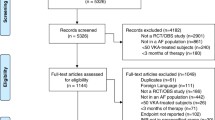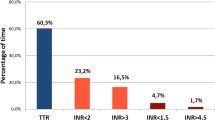Abstract
Background/objectives
Expert oral anticoagulation management is the key to good outcomes and is performed variably in different health care systems throughout the world. We set out to assess the quality of anticoagulation management in five countries in patients receiving vitamin K antagonists (VKAs) for stroke prophylaxis in chronic non-valvular atrial fibrillation (NVAF), and to compare the anticoagulation management practices in these countries.
Methods and results
This was a retrospective, multi-centre cohort study in the United States, Canada, France, Italy, and Spain. About 1,511 patients were randomly recruited from representative practices (routine medical care (RMC) in the US, Canada, and France; anticoagulation clinics in Italy and Spain) and data pertaining to their oral anticoagulation care were abstracted from their medical records. The predominant anticoagulant in use was warfarin in the US, Canada, and Italy; acenocoumarol in Spain; and fluindione in France. Documentation of care was poor in the US, Canada, and France, countries where RMC was studied. Percent INRs or time-in-therapeutic range was greater in the two anticoagulation clinic samples compared with the RMC samples.
Conclusion
Oral anticoagulation care varies considerably from country to country. Findings suggest that anticoagulation clinic care (ACC) may provide better outcomes as assessed by international normalized ratio (INR) time-in-range. Physicians tend to under treat more than over treat. Finally, documentation of care is often inadequate.
Condensed Abstract Oral anticoagulation management (routine medical care or anticoagulation clinic care) was retrospectively assessed in 5 countries using a uniform, structured assessment tool. Major management differences were detected, especially between anticoagulation clinic care and routine care. Documentation was often a problem in the latter setting. Less time in therapeutic INR range was noted in routine medical care. Findings suggest that anticoagulation clinic care may provide better outcomes as assessed by international normalized ratio (INR) time-in-range. Physicians tend to under treat more than over treat. Finally, documentation of care is often inadequate.

Similar content being viewed by others
References
Ansell J, Hirsh J, Poller L, Bussey H, Jacobson A, Hylek E (2004) The pharmacology and management of the vitamin K antagonists. Chest 126(Suppl):202S–231S
Cortelazzo S, Finazzi G, Viero P, Galli M, Remuzzi A, Parenzan L, Barbui T (1993) Thrombotic and hemorrhagic complications in patients with mechanical heart valve prosthesis attending an anticoagulation clinic. Thromb Haemost 69:316–320
Chiquette E, Amato MG, Bussey HI (1998) Comparison of an anticoagulation clinic and usual medical care: anticoagulation control, patient outcomes, and health care costs. Arch Intern Med 158:1641–1647
Samsa GP, Matchar DB, Goldstein LB, Boinito AJ, Lux LJ, Witter DM, Bian J (2000) Quality of anticoagulation management among patients with atrial fibrillation: results from a review of medical records from two communities. Arch Intern Med 160:967–973
Gottlieb LK, Salem-Schatz S (1994) Anticoagulation in atrial fibrillation: does efficacy in clinical trials translate into effectiveness in practice? Arch Intern Med 154:1945–1953
Holm T, Lassen JF, Husted SE, Heickendorf L (1999) Identification and surveillance of patients on oral anticoagulant therapy in a large geographic area-use of laboratory information systems. Thromb Haemost 82(Suppl):S858–S859
Beyth RJ, Quinn L, Landefeld CS (2000) A multicomponent intervention to prevent major bleeding complications in older patients receiving warfarin: a randomized, controlled trial. Ann Intern Med 133:687–695
Witt DM, Sadler MA, Shanahan RL, Mazzoli G, Tillman DJ (2005) Effect of a centralized clinical pharmacy anticoagulation service on the outcomes of anticoagulation therapy. Chest 127:1515–1522
Chamberlain MA, Sageser NA, Ruiz D (2001) Comparison of anticoagulation clinic patient outcomes with outcomes from traditional care in a family medicine clinic. J Am Board Fam Pract 14:16–21
Ministerio de Sanidad y Consumo. Catálogo Nacional de Hospitales (1999) Madrid: Ministerio de Sanidad y Consumo y Boletín Oficial del Estado; 2001
Rosendaal FR, Cannegieter SC, van der Meer FJM, Briet E (1993) A method to determine the optimal intensity of oral anticoagulant therapy. Thromb Hemost 69:236–239
Upshur RE, Papoushek C, Macdonald D, Dantas G (2003) Short report: managing anticoagulation. Comparison of results at three primary care centres. Can Fam Physician 49:181–184
Pengo VC, Legnani C, Noventa F, Palareti G, ISCOAT Study Group (2001) Oral anticoagulant therapy in patients with nonrheumatic atrial fibrillation and risk of bleeding: a multicenter inception cohort study. Thromb Haemost 85:418–422
Menendez-Jandula B, Souto JC, Oliver A, Montserrat I, Quintana M, Gich I, Bonfill X, Fontcuberta J (2005) Comparing self-management of oral anticoagulant therapy with clinic management. Ann Intern Med 142:1–10
Barcellona D, Contu P, Sorano GG, Pengo V, Marongiu F (2000) The management of oral anticoagulant therapy: the patient’s point of view. Thromb Haemost 83:49–53
Gross CP, Vogel EW, Dhond AJ, Marple CB, Edwards RA, Hauch O, Demers EA, Ezekowitz M (2003) Factors influencing physicians’ reported use of anticoagulation therapy in nonvalvular atrial fibrillation: a cross-sectional survey. Clin Ther 25:1750–1764
Devereaux PJ, Anderson DR, Gardner MJ, Putnam W, Flowerdew GJ, Brownell BF, Nagpal S, Cox JL (2001) Differences between perspectives of physicians and patients on anticoagulation in patients with atrial fibrillation: observational study. Br Med J 323:1218–1221
Cannegieter SC, Rosendaal FR, Wintzen AR, van der Meer FJM, Vandenbroucke JP, Briet E (1995) Optimal oral anticoagulant therapy in patients with mechanical heart valve prostheses. N Engl J Med 333:11–17
Hylek EM, Singer DE (1994) Risk factors for intracranial haemorrhage in outpatients taking warfarin. Ann Intern Med 120:897–902
Hylek EM, Skates SJ, Sheehan MA, Singer DE (1996) An analysis of the lowest effective intensity of prophylactic anticoagulation for patients with nonrheumatic atrial fibrillation. N Engl J Med 335:540–546
Acknowledgements
We express our sincere thanks to the participating physicians and clinics and to the local study co-ordinators (Ole Hauch and Gail Wygant, USA; Amin Haiderali, Canada; Hervé Lamarque and Maud Woessner, France; Alessandra Cheli and Cristina Negrini, Italy; Rosario Marazuela, Spain), and Jonas Carlsson for statistical support. This study was funded by AstraZeneca.
Author information
Authors and Affiliations
Corresponding author
Additional information
This study was presented in part at the 8th National Conference on Anticoagulant Therapy, Orlando, Fl, May 2005, sponsored by the Anticoagulation Forum. This study was supported by a grant from AstraZeneca, Molndal, Sweden.
Rights and permissions
About this article
Cite this article
Ansell, J., Hollowell, J., Pengo, V. et al. Descriptive analysis of the process and quality of oral anticoagulation management in real-life practice in patients with chronic non-valvular atrial fibrillation: the international study of anticoagulation management (ISAM). J Thromb Thrombolysis 23, 83–91 (2007). https://doi.org/10.1007/s11239-006-9022-7
Published:
Issue Date:
DOI: https://doi.org/10.1007/s11239-006-9022-7




